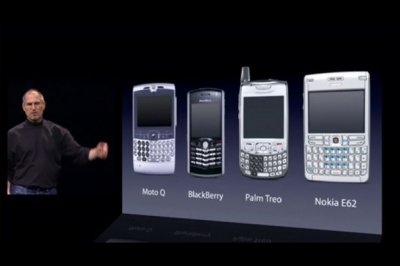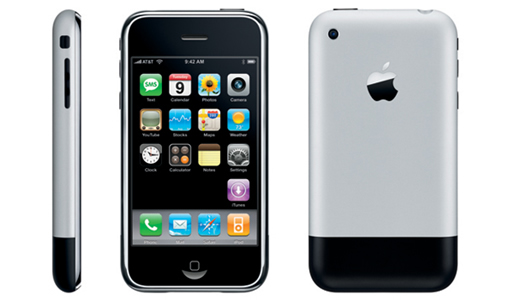Seven years ago, Steve Jobs introduced the iPhone, shaking up the mobile and smartphone industry. Today, as I visit the thousands of exhibitor booths at CES 2014, it’s evident just how much the smartphone has revolutionized not just consumer technology, but businesses and specialized markets. Apple isn’t even attending CES but the presence of the iPhone and iOS software is seen everywhere; accessories optimize these devices for different environments, apps are developed to work seamlessly across iOS devices and other mobile devices are launched to compete with the revolutionary iPhone.
In an era dominated by Palm Pilots and BlackBerrys, Apple completely redesigned the norm for smartphones from this:

to this:

When Jobs announced the iPhone, he led with:
“This is a day I've been looking forward to for two-and-a-half years. Every once in a while, a revolutionary product comes along that changes everything. And Apple has been -- well, first of all, one's very fortunate if you get to work on just one of these in your career. Apple's been very fortunate. It's been able to introduce a few of these into the world. 1984, introduced the Macintosh. It didn't just change Apple. It changed the whole computer industry. In 2001, we introduced the first iPod, and it didn't just change the way we all listen to music, it changed the entire music industry. Well, today, we're introducing three revolutionary products of this class. The first one is a widescreen iPod with touch controls. The second is a revolutionary mobile phone. And the third is a breakthrough Internet communications device. So, three things: a widescreen iPod with touch controls; a revolutionary mobile phone; and a breakthrough Internet communications device. An iPod, a phone, and an Internet communicator. An iPod, a phone...are you getting it? These are not three separate devices, this is one device, and we are calling it iPhone. Today, Apple is going to reinvent the phone, and here it is. No, actually here it is, but we're going to leave it there for now.”
On its seventh birthday, here are seven facts about the original iPhone, and how they’ve changed.
1. The iPhone was only available through AT&T.
That lasted until 2011, when the iPhone was available through Verizon (News  - Alert) and then Sprint. T-Mobile, the fourth-largest U.S. carrier, began selling the iPhone in 2013.
- Alert) and then Sprint. T-Mobile, the fourth-largest U.S. carrier, began selling the iPhone in 2013.
2. The original iPhone cost $499 and had 4GB of storage. The 8 GB model cost $599.
Today, the iPhone 5s holds up to 32GB of storage, which costs $399. The 16GB model (which was first introduced in 2008) is $199 and the 32GB is $299.
3. The first iPhone took 74 days to reach one million sales.
The one millionth 3G sold just three days after it was launched in 2008. Apple sold more than one million preorders for the iPhone 4s during the first 24 hours it was available online, and it sold nine million iPhone 5s and 5c models just three days after they were launched.
4. The original iPhone display had 153600 pixels, at a display resolution of 320x480 pixels at 163 ppi.
The iPhone 5s display has a display resolution of 1136x640 pixels at 326 ppi.

5. When Jobs demoed the stocks app in 2007, Apple’s stock was $87.90.
Today it’s $537.23.
6. The original iPhone offered up to five hours of battery life for talk, video and browsing.
It bumped that up to eight hours of talk time, 24 hours of audio playback, seven hours of video playback and six hours of Web browsing in 2007. The iPhone 5s offers up to 10 hours on 3G of talk time, up to 250 hours of standby, and up to eight hours on 3G for Internet use, up to 10 hours of Internet use on LTE (News - Alert) and up to 10 hours of Internet use on Wi-Fi. The 5s also offers up to 10 hours of video playback and up to 40 hours of audio playback.
7. The first-generation iPhone had a fixed-focus 2.0-megapixel camera on the back.
That continued with the 3G until the iPhone 3Gs, which had a 3.2-megapixel camera that could also capture video. Today, the iPhone 5s features 8 megapixels and a number of features, including “True Tone” flash, f/2.2 aperture, autofocus, tap to focus, panorama, auto image stabilization and photo tagging. The video also features 1080p HD video recording, slow motion video, video stabilization and the ability to take photos simultaneously while recording a video.
Edited by
Cassandra Tucker